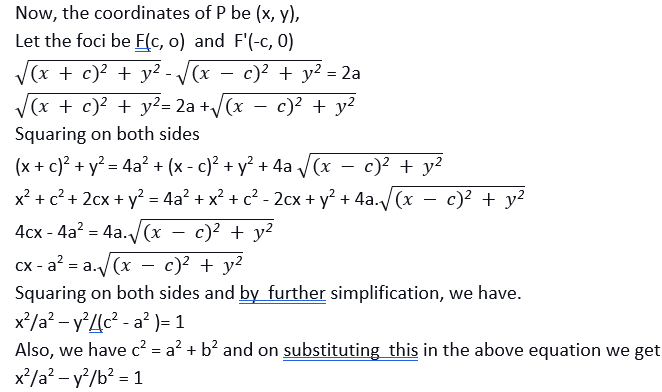In mathematics, a hyperbola refers to an important conic section whose formation takes place by the intersection of the double cone by a plane surface. This does not take place necessarily at the centre. This conic section is symmetric along the conjugate axis, and it has many commonalities with the ellipse.
There is an application of concepts like eccentricity, latus rectum, directrix, and foci to a hyperbola. Many examples of hyperbolas can be found in our life, like some types of building structures, optical glasses, radio systems, etc. A Cartesian equation of hyperbola refers to an equation in terms of x and y only. Let us learn more about hyperbola, including the Cartesian Equation and hyperbola formula. Its calculation can take place easily with the help of a hyperbola calculator.
What is the Cartesian System?
The Cartesian system is a system used for the labelling of points in a plane. The derivation of this particular system is the number line. Study the following points to understand this system better:
- There are two perpendicular lines in it, which are simply the X-axis and Y-axis.
- The name Cartesian is given to the plane.
- The axes have a point of intersection. This point is known as the zero of this system. You can easily express it as 0. Therefore, the expression of the origin’s coordinates takes place as (0, 0).
- The two coordinate axes undertake the division of the plane into four parts. Each of these parts is known among experts as a quadrant.
- The plotting of the two real numbers can take place together to describe the position of any plane point in a unique manner.
- You can measure distances between any two points in the Cartesian plane. These distances can either be positive or negative.
Understanding the Cartesian Equation Of Hyperbola
In the standard position, the Cartesian equation of the hyperbola is as follows:
x2/a2 – y2/b2 = 1,
Also a, b > 0.
This has the following implication:
- The centre is at the origin, (0, 0).
- The major axis—containing the vertices and focal points, is the 𝑥-axis. Its expression takes place by saying that the conic structure has an east-west opening.
- Also, (−a, 0) and (a, 0) are the vertices.
- Also, y = bx/a and y = -bx/a are the asymptotes of the lines.
- The foci points shall be (-c, 0) and (c, 0)
Note that the geometric definition of the conic structure is such that the difference between the distances to the foci happens to be constant.
Derivation of Hyperbola Equation
As per the definition of hyperbola, let us consider a point P.
Also, consider the difference of its distance from the two foci F, F’ = 2a.
|PF’ – PF| = 2a

Squaring on both sides and by
This is the derivation of the standard equation of the hyperbola. Using a hyperbola calculator, this can be done easily.
Hyperbola Formula
A hyperbola is an open curve that is characterised by two branches. The hyperbola formula is as follows:
Equation of hyperbola formula: (x – x0)2 / a2 – ( y – y0)2 / b2 = 1
Major and minor axis formula: y = y0 happens to be the major axis, its length is 2a, whereas minor axis x = x0 is the minor axis, and its length is 2b
Asymptotes formula:
Asymptotes refer to straight lines that touch the conic section at infinity.
The formula is, y = y0− (b / a)x + (b / a)x0
Also, y = y0 + (b / a)x – (b / a)x0
Vertex of formula:
(a, y0) and (−a, y0)
Semi-latus rectum(p) of hyperbola formula:
p = b2 / a
Here,
The centre points = x0, y0
The semi-major axis is a.
The semi-minor axis is b.
Conclusion
A hyperbola refers to an important conic section whose production happens by the intersecting of the double cone by a plane surface. There is an application of eccentricity, latus rectum, directrix, and foci concepts to hyperbolas.
The Cartesian system is a system used for labelling points in a plane. The Cartesian equation of hyperbola is an equation in terms of x and y only. It has many practical applications and is important to understand as a mathematical concept.
 Profile
Profile Settings
Settings Refer your friends
Refer your friends Sign out
Sign out






